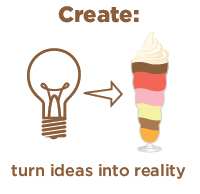Welcome back to the Be A Kitchen Innovator blog series on The Knickerbocker Glory! This is the fifth post in the series that will discuss Bringing Ideas to Life. I hope you find it useful.
Bringing Ideas to Life
In the first, second third and fourth posts of this series we talked about…
- Writing our statement of purpose and giving it a twist making sure that we were being clear about what we want to accomplish.
- The importance of finding new facts to inspire us.
- Creating themes and opportunity areas – the mis en place of innovation – where we organise our facts to tell a story.
- Generating ideas, using an idea sheet and getting those ideas on paper to create a roadmap for what will later be brought to life.
This is the point in the process where the food hits the frying pan so to speak. The ideas we generated are now brought to life. They are made into real products or processes. Once you have your ideas, it is incredibly important to make them real, i.e., taking what is literally written on those idea sheets and transforming that written expression (words, doodles, drawings, etc.) into the real thing. This is an important pillar of innovation. After all, in its simplest form, Innovation is the act of bringing a new idea to life! Actually taking the idea from paper and bringing it into reality will help take it one step closer to meeting your goals. In cooking, this is more obvious. It helps to make the new dish so it can actually be tasted, so the new flavor combinations and textures can be experienced and then perfected. The importance of physically creating new ideas is not just true for cooking though. Bringing a new idea into reality gives it much more meaning. It not only brings excitement to the idea that will help carry it forward, but it will certainly be easier to perfect after seeing it and experiencing it.
Lets take a look at the complete idea sheet for the Knickerbocker Glory that pays homage to Canada. Having the idea is great, but as discussed above, an idea does you no good unless you act on it and make it real. No one ever made any money on just an idea or thought, they had to bring those ideas into the world and get them working.
At this step in the innovation process it is time to get into the kitchen and develop the recipes that will go into the dessert and ultimately create the Knickerbocker Glory. We would do this for each of our ideas translating them into the real world so they can be experienced. It does not matter if the final product is a dessert or a new process. It must be brought to life or it is just an idea.
When bringing ideas to life it is important to stick to that idea sheet and be true to it. This way we have a good starting point that is reflective of all the previous work we have done. There will be time to make tweaks in the next step, but it is important to have an objective starting point without any creeping incrementalism. Creeping incrementalism is when people add stuff to ideas arbitrarily. Changes to an idea should be made with constructive feedback from sources that make sense. After the idea is brought to life it is a great time to be collecting this constructive feedback, understanding if the idea meets expectations, what people like and don’t like about the idea or what is and isn’t possible to create given some technical limitation. Perhaps the above Knickerbocker Glory idea is going to be used in a restaurant, but edible gold leaf is prohibitively expensive. It can be used to bring the idea to life, but through feedback it may be removed or changed to something more affordable.
One thing that might be considered before bringing all the ideas to life it to have a ranking exercise. If 25 new ideas were created it might be hard to bring all of them to life. Using some objective criteria, the ideas might be judged and ranked first. This could save a lot of time and resource. The ideas lower on the list can be revisited later when it is more appropriate.
In the next step – iteration, all the feedback can be incorporated to make the idea even better or even more acceptable to those it is being created for.
Remember, innovation in its simplest form is bringing new ideas to life. Having ideas only is not enough. Bringing ideas to life is one of the most important steps in innovation so get those ideas off paper and into reality!
Do you have any questions about Bringing Ideas to Life? Have you used a process like this before in your kitchen or work? Let us know all about it in the comments or on Facebook.
The Culinary Exchange can also be found on Twitter, Instagram, Pinterest, Google+ and YouTube.

 From Knickerbocker Glory: A Chef’s Guide to Innovation in the Kitchen and Beyond
From Knickerbocker Glory: A Chef’s Guide to Innovation in the Kitchen and Beyond


